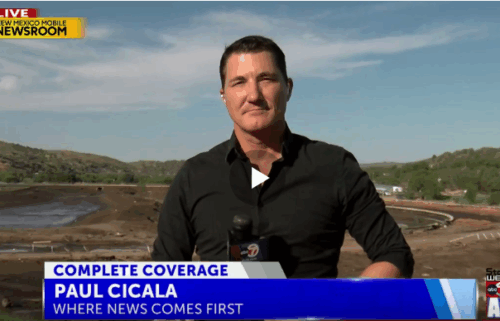The DART mission is about to collide with an asteroid. What to expect
By Ashley Strickland, CNN
On Monday, a NASA spacecraft will deliberately slam into an asteroid called Dimorphos.
The Double Asteroid Redirection Test mission, or DART, aims to see if this kind of kinetic impact can help deflect an asteroid posing a threat to Earth.
“We are moving an asteroid,” said Tom Statler, NASA program scientist for the DART mission. “We are changing the motion of a natural celestial body in space. Humanity has never done that before.”
Here’s what you need to know about this mission.
What exactly is DART?
The DART spacecraft is about the size of a school bus. It has been traveling to reach its asteroid target since launching in November 2021. The spacecraft will arrive at the asteroid system on September 26. Impact is expected at 7:14 p.m. ET.
Where is it going?
The spacecraft is heading for a double-asteroid system, where a tiny “moon” asteroid, named Dimorphos, orbits a larger asteroid, Didymos.
Didymos. which means “twin” in Greek, is roughly 2,560 feet (780 meters) in diameter. Meanwhile, Dimorphos measures 525 feet (160 meters) across, and its name means “two forms.”
At the time of impact, Didymos and Dimorphos will be relatively close to Earth — within 6.8 million miles (11 million kilometers).
Neither Dimorphos nor Didymos is at risk of colliding with Earth — before or after the collision takes place.
What will DART do?
DART is going down in a blaze of glory. It will set its sights on Dimorphos, accelerate to 13,421 miles per hour (21,600 kilometers per hour) and crash into the moon nearly head-on.
The spacecraft is about 100 times smaller than Dimorphos, so it won’t obliterate the asteroid.
Instead, DART will try to change the asteroid’s speed and path in space. The mission team has compared this collision to a golf cart crashing into one of the Great Pyramids — enough energy to leave an impact crater.
The impact will change Dimorphos’ speed by 1% as it orbits Didymos. It doesn’t sound like much, but doing so will change the moon’s orbital period.
The nudge will shift Dimorphos slightly and make it more gravitationally bound to Didymos — so the collision won’t change the binary system’s path around the Earth or increase its chances of becoming a threat to our planet.
What will we get to see?
The spacecraft will share its view of the double-asteroid system through an instrument known as the Didymos Reconnaissance and Asteroid Camera for Optical navigation, or DRACO.
This imager, which serves as DART’s eyes, will allow the spacecraft to identify the double-asteroid system and distinguish which space object it’s supposed to strike.
This instrument also is a high-resolution camera that aims to capture images of the two asteroids to be streamed back to Earth at a rate of one image per second in what will appear nearly like a video. You can watch the live stream on NASA’s website, beginning at 6 p.m. ET Monday.
Didymos and Dimorphos will appear as pinpricks of light about an hour before impact, gradually growing larger and more detailed in the frame.
Dimorphos has never been observed before, so scientists can finally take in its shape and the appearance of its surface.
We should be able to see Dimorphos in exquisite detail before DART crashes into it. Given the time it takes for images to stream back to Earth, they will be visible for eight seconds before a loss of signal occurs and DART’s mission ends — if it was successful.
The spacecraft also has its own photojournalist along for the ride.
A briefcase-size satellite from the Italian Space Agency hitched a ride with DART into space. Called the Light Italian CubeSat for Imaging of Asteroids, or LICIACube, it detached from the spacecraft on September 11. The satellite is traveling behind DART to record what happens from a safe perspective.
Three minutes after impact, LICIACube will fly by Dimorphos to capture images and video of the impact plume and maybe even spy on the impact crater. The CubeSat will turn to keep its cameras pointed at Dimorphos as it flies by.
The images and video, while not immediately available, will be streamed back to Earth in the days and weeks following the collision.
How will we know if the mission was successful?
The LICIACube won’t be the only observer watching. The James Webb Space Telescope, the Hubble Space Telescope and NASA’s Lucy mission will observe the impact. The Didymos system may brighten as its dust and debris is ejected into space, said Statler, the NASA program scientist.
But ground-based telescopes will be key in determining if DART successfully changed the motion of Dimorphos.
The Didymos system was discovered in 1996, so astronomers have plenty of observations of the system. After the impact, observatories around the world will watch as Dimorphos crosses in front of and moves behind Didymos.
Dimorphos takes 11 hours and 55 minutes to complete an orbit of Didymos. If DART is successful, that time could decrease by 73 seconds, “but we actually think we’re going to change it by about 10 minutes,” said Edward Reynolds, DART project manager at the Johns Hopkins University Applied Physics Laboratory.
Statler said he would be surprised if a measurement of the period change came in less than a few days but even more so if it took more than three weeks.
What if DART misses and doesn’t hit the asteroid?
“I’m highly confident that we were going to hit on Monday, and it will be a complete success,” said Lindley Johnson, NASA planetary defense officer.
But if DART misses its proverbial dart board, the team will be ready to ensure the spacecraft is safe and all its information downloaded to figure out why it didn’t hit Dimorphos.
The Applied Physics Laboratory’s Mission Operations Center will intervene if necessary, even though DART will have been operating autonomously for the final four hours of its journey.
It takes 38 seconds for a command to travel from Earth to the spacecraft, so the team can react quickly. The DART team has 21 contingency plans it has rehearsed, said Elena Adams, DART mission systems engineer at the Applied Physics Lab.
Why do we need to test this, and why on this asteroid?
Dimorphos was chosen for this mission because its size is comparable to asteroids that could pose a threat to Earth. An asteroid the size of Dimorphos could cause “regional devastation” if it hit Earth.
The asteroid system is “the perfect natural laboratory” for the test, Statler said.
The mission will allow scientists to have a better understanding of the size and mass of each asteroid, which is crucial to understanding near-Earth objects.
Near-Earth objects are asteroids and comets with an orbit that places them within 30 million miles (48.3 million kilometers) from Earth. Detecting the threat of near-Earth objects that could cause grave harm is a primary focus of NASA and other space organizations around the world.
No asteroids are currently on a direct impact course with Earth, but more than 27,000 near-Earth asteroids exist in all shapes and sizes.
The valuable data collected by DART will contribute to planetary defense strategies, especially the understanding of what kind of force can shift the orbit of a near-Earth asteroid that could collide with our planet.
Why don’t we just blow up the asteroid, like in ‘Armageddon’?
Movies make combating asteroid approaches seem like a hurried scramble to protect the planet, but “that’s not the way to do planetary defense,” Johnson said. Blowing up an asteroid could be more dangerous because then its pieces could be on a collision course with Earth.
But NASA is considering other methods of changing the motion of asteroids.
The DART spacecraft is considered to be a kinetic impactor that could change the speed and path of Dimorphos. If DART is successful, it could be one tool for deflecting asteroids.
Another option is a gravity tractor, which relies on mutual gravitational attraction between a spacecraft and an asteroid to tug the space rock out of its impacting trajectory into a more benign one, Johnson said.
Another technique is ion beam deflection, or shooting an ion engine at an asteroid for long periods of time until the ions change the asteroid’s velocity and orbit.
But both of these take time.
“Any technique that you can imagine that changes the orbital speed of the asteroid in orbit is a viable technique,” Johnson said.
An international forum called the Space Planning Commission has brought 18 national space agencies together to assess what might be best to deflect an asteroid, depending on its size and path.
Finding populations of hazardous asteroids and determining their sizes are priorities of NASA and its international partners, Johnson said. The design for a space-based telescope called the Near-Earth Object Surveyor mission is currently in review.
Will any other spacecraft fly by Dimorphos in the future?
The Didymos system won’t be lonely for too long. To survey the aftermath of the impact, the European Space Agency’s Hera mission will launch in 2024. The spacecraft, along with two CubeSats, will arrive at the asteroid system two years later.
Hera will study both asteroids, measure physical properties of Dimorphos, and examine the DART impact crater and the moon’s orbit, with the aim of establishing an effective planetary defense strategy.
The-CNN-Wire
™ & © 2022 Cable News Network, Inc., a Warner Bros. Discovery Company. All rights reserved.


